
Wine Culture and Information since 2002 - Volume 22
 Wine Culture and Information since 2002 - Volume 22 |
|
CinnamonA small tree growing in the forests of Ceylon island, in the Western Indies, has strongly influenced the trades from East to Europe as well as being a strategic good for naval trades of the past |
|
A tree providing great help to humans, both as a spice to flavoring and aromatizing daily foods, as well as a remedy. Cinnamon, whose scientific name is Cinnamomum Zeylanicum, is a small evergreen tree growing wild in forests, it does not have a specific geographical origin, it is however certain it comes from Ceylon or southern India. Today its cultivation has spread in the Seychelles, Java, Sumatra, Brazil and Jamaica. The scientific name derives from the Arab words “kin” and “anomon”, meaning “aromatic plant from China”. The reason of these terms refers to another cinnamon, the one coming from China, whereas the cinnamon from Ceylon, the one we are talking about, arrived in Europe in the sixteenth century. The name “cinnamon” derives from the Arab kin-anomon, and the names used in past times in Europe also derived from this term, for example, in Italy cinnamon was once called cinnamomo. With the term “cinnamon” is referred the spice prepared with the bark of two vegetal species and both belonging to the Cinnamomum family: Cinnamomum Zeylanicum and Cinnamomum Cassia. The Cinnamomum Zeylanicum is an evergreen tree whose bark - very thin and fragile - is being dried therefore getting the characteristic rolled aspect. The texture is smooth and the color is brown, getting darker inside. This spice is also known as queen cinnamon, maybe for emphasizing its superior quality and aroma. Cinnamomum Cassia, or Chinese cinnamon, is a tree from China, and its dried bark has a wrinkled aspect, a thickness of more than one millimeter and the color tends to gray. It also has a weaker aroma and an inferior quality than Ceylon's cinnamon.
Cinnamon was used by human beings since ancient times: it seems Chinese used it since 2,700 BC, whereas Egyptians used cinnamon during the embalming processes since 2,000 BC. Romans considered cinnamon sacred, and the emperor Nero burnt it during the funeral of his mother. In the Middle Age the most noble classes used cinnamon as a sign of richness and power. During banquets were served cinnamon and other spices, probably for impressing guests. The custom of donating spices to princes and queens, makes us understand the importance they had at those times. It was not by chance - and as it has been proven - cinnamon and black pepper were the main goods traded by the economies of the past. After the journey of Vasco de Gama in 1505 and the following occupation of Ceylon, the trade of cinnamon received a significative impulse, up to reaching a level which was capable of influencing the trades and the interests of naval powers of those times. The high profits ensured by spices, make us understand the reason why so many great seafaring of the past decided to start risky and hard journeys - facing serious dangers for themselves and the life of the crew - with no instruments, transported by winds, crossing unknown seas. Remarkable enterprises which certainly are hard for twenty century's modern crews as well. Many seafaring of the past sailed the seas in search for spices and high profits: Bartolomeo Diaz (1487), the Portuguese who discovered the most southern language in Africa, and that by circumnavigating it reached Indies; Vasco de Gama (1497), that after a very risky journey, he was successful in reaching Indies thanks to the advices of Arab merchants; Christopher Columbus (1492) who tried to find a new way for the Indies; Pedro Alvares Cabral (1500) who sailed towards Indies (and accidentally discovered Brazil) with thirteen ships and came back with only six but full of black pepper. The people of the Middle Age made a wide use of spices. The reason of this strong use can be explained by the life styles of those times. The variety and abundance of vegetables was not as high as we have it today, during wintertime the scarcity of forage and vegetables forced people to butcher animals and to preserve it with salt in order to be consumed in the cold season. Meals were therefore pretty repetitive: meat kept in salt and some vegetables. In order to make food more tasty - as well as to cover any bad smell or flavor - they used spices. Whoever traveled in India or Africa, in those areas where the variety of food is scarce (rice and lentils, rice and chickpeas, for example) will have noticed the huge quantity of spices used to diversify, renew and make more pleasing the miserable meals, otherwise insipid and repetitive. The condition during the Middle Age was not that different. For this reason foods were enriched with spices and very tasty or hot sauces. Only spices could give countless flavors and aromas to the same meals. The use of spices was not exclusively reserved to rich and noble people, their use was also common among other people: this explains the wide consumption and the huge demand of such goods. The first great merchants of history were Arabs, who transported goods from India and China to the Mediterranean and then were sold to Europeans. The greatest spice merchants were Venetians. Around the half of fifteenth century Turks began to intercept and depredate the caravans coming from the East, for this reason spices began to become rare in Europe. In the sixteenth century Portuguese found a new way - by circumnavigating Africa - and arrived in India while avoiding the dangerous Turks. After two centuries Portuguese had the dominion of trades with Indies, it was then the turn of Dutch and then of English. The golden age of cinnamon and other spices was obscured by the introduction of new products from America. Coffee, sugar and chocolate had a wide preference in most of worldwide people, and the trade of spices faced a long time of recession. Today spices are living a new youth, both for the ease of traveling and to know new customs and new traditions, as well as for the interest of new habits and customs in the Western world. Among the many, there are the cooking cultures of distant countries, now not so distant, with their markets rich in spices and for their cooking rich in aromas and tropical colors, cheerful and lively to the eyes and so inviting to the taste. The island of Ceylon is, still today, the main exporter of cinnamon in the world.
|
||||||||||||
|
Cinnamon is obtained by cutting young branches of the plant - two or three years old - the bark is then removed, as well as separating the internal corky part, and the strips are being dried one inside another. During the drying process, the bark gets rolled therefore giving the spice its typical aspect as we usually know it. The part of the plant used to make the spice is the bark, whereas from debris of the bark and dried leaves is being obtained the oil. Both the oil and the bark of this spice contain cinnamon aldehyde and are both used for flavoring foods and liquors, as well as ingredients for incense and perfumes. Its pleasing and tropical aroma is widely used in aromatherapy. Cinnamon has stimulant and digestive properties, antispasmodic, antibacterial, it is a remedy for flu and it is a disinfectant for the bowel and vermifuge. It is also a stimulant for the nervous system and accelerates heart beat as well as the respiratory rhythm, therefore an excessive and uncontrolled consumption can also be cause of convulsive states. Cinnamon is used as an antiseptic and as a coadjuvant for the elimination of intestinal gases. According to a culinary point of view, cinnamon is widely used in Eastern cooking, whereas in the western world is mainly used in pastry cooking and for aromatizing wine beverages. Cinnamon, because of its antibacterial properties, is used for preserving meat. A researcher of the US Department of Agriculture's Human Nutrition Research Center of Beltsville (USA), while was studying the effects of common foods in the level of sugar and cholesterol in blood, has examined some people to whom were given apple pie, a dessert which has in its ingredients cinnamon. When the level of sugar and cholesterol was tested, the scientist noticed a substance contained in cinnamon - more precisely the MHCP polyphenol - kept low the quantity of sugar and cholesterol of blood in people affected by type 2 diabetes. It seems that a daily consumption of about 2-3 grams of cinnamon powder, can lower - in few weeks - the quantity of sugar in blood of about 20% as well as lowering the quantity of bad cholesterol and triglycerides. From a plant apparently belonging to the same family of cinnamon, cinnamon alba, is obtained false cinnamon, similar to the real one both in the aroma and taste, however having less value. Whenever possible, it is recommended using cinnamon sticks, as powder tends to rapidly lose its characteristic aroma with time.
|
AquavitaeReview of Grappa, Distillates and Brandy |
|
|
| Distillates are rated according to DiWineTaste's evaluation method. Please see score legend in the "Wines of the Month" section. |
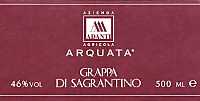
|
|
Grappa di Sagrantino |
|
| Adanti (Italy) | |
| (Distiller: Distillerie Aquileia) | |
| Raw matter: Pomace of Sagrantino | |
| Price: € 25.00 - 50cl | Score: |
| The grappa is colorless, limpid and crystalline. The nose denotes intense, clean and pleasing aromas of blackberry, hazelnut, licorice, black cherry and plum with almost imperceptible alcohol pungency. In the mouth is intense with evident alcohol pungency which tends to dissolve rapidly, good correspondence to the nose, pleasing sweet hint and good smoothness. The finish is persistent with flavors of black cherry, blackberry and licorice. This grappa is produced with discontinuous steam operated alembic still. Alcohol 46%. | |

|
|
Grappa di Nero d'Avola 2003 |
|
| Giovi (Italia) | |
| Raw matter: Pomace of Nero d'Avola | |
| Price: € 14.55 - 50cl | Score: |
| This grappa is colorless, limpid and crystalline. The nose reveals intense, clean, pleasing and refined aromas of plum, raspberry, black cherry, violet, blackberry and licorice with almost imperceptible alcohol pungency. In the mouth is intense with balanced alcohol pungency which tends to dissolve rapidly, good correspondence to the nose, pleasing and balanced sweet hits. The finish is persistent with flavors of plum, licorice and black cherry. This grappa is produced with a water bath discontinuous alembic still. Alcohol 42%. | |
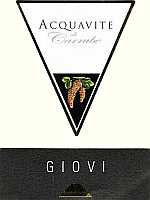
|
|
Acquavite di Carrube 2003 |
|
| Giovi (Italy) | |
| Raw matter: Carob | |
| Price: € 19.00 - 50cl | Score: |
| This brandy is colorless, limpid and crystalline. The nose denotes intense, clean and pleasing aromas of carob, tobacco, peach, hazelnut and chamomile. In the mouth is intense with alcohol pungency which tends to dissolve rapidly, good correspondence to the nose, good and pleasing sweet hint, pleasing roundness. The finish is persistent with flavors of carob and hazelnut. This brandy is produced with a water bath discontinuous alembic still. Alcohol 45%. | |
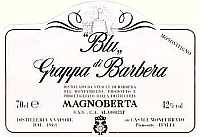
|
|
Grappa di Barbera “Blu” |
|
| Distilleria Magnoberta (Italy) | |
| Raw matter: Pomace of Barbera from Monferrato Casalese | |
| Price: € 14.50 - 70cl | Score: |
| This grappa is colorless, limpid and crystalline. The nose denotes intense, clean and pleasing aromas of cherry, raspberry, licorice and hazelnut with perceptible alcohol pungency. In the mouth is intense with evident alcohol pungency which however tends to dissolve rapidly, pleasing sweet hint, good roundness. The finish is persistent with flavors of raspberry and cherry. This grappa is produced with a discontinuous alembic still operating at low pressure. Alcohol 42%. | |
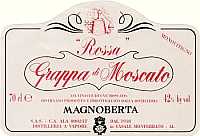
|
|
Grappa di Moscato “Rossa” |
|
| Distilleria Magnoberta (Italy) | |
| Raw matter: Pomace of Muscat Blanc from Canelli | |
| Price: € 17.00 - 70cl | Score: |
| This grappa is colorless, limpid and crystalline. The nose reveals intense, clean, pleasing and refined aromas of grape, peach, broom, rose, pear, hints of sage and almost imperceptible alcohol pungency. In the mouth is intense, with balanced alcohol pungency which tends to dissolve rapidly, good correspondence to the nose, good and pleasing sweet hints, agreeable smoothness. The finish is persistent with flavors of peach, pear and grape. This grappa is produced with a discontinuous alembic still operating at low pressure. Alcohol 42%. | |

|
|
Grappa di Dolcetto d'Acqui 1999 |
|
| Casa Luparia (Italy) | |
| Raw matter: Pomace of Dolcetto d'Acqui | |
| Price: € 16.50 - 50cl | Score: |
| This grappa is colorless, limpid and crystalline. The nose reveals intense, clean, pleasing and refined aromas of raspberry, cherry, cyclamen, rose and strawberry with almost imperceptible alcohol pungency. In the mouth is intense with balanced alcohol pungency which tends to dissolve rapidly, good correspondence to the nose, pleasing and balanced sweet hints, agreeable. The finish is persistent with flavors of raspberry, strawberry and cherry. A well made grappa. This grappa is produced with a discontinuous alembic still operating at low pressure. Alcohol 42%. | |
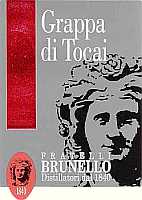
|
|
Grappa di Tocai 1999 |
|
| Fratelli Brunello (Italy) | |
| Raw matter: Pomace of Tocai Friulano | |
| Price: € 15.50 - 70cl | Score: |
| This grappa is colorless, limpid and crystalline. The nose denotes intense, clean and pleasing aromas of apple, almond, licorice and pear with almost imperceptible alcohol pungency. In the mouth is intense with balanced alcohol pungency which tends to dissolve rapidly, good and pleasing sweet hint, pleasing roundness. The finish is persistent with flavors of apple, almond and a pleasing sweet hint. This grappa is produced with a discontinuous steam operated alembic still. Alcohol 40%. | |
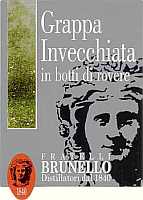
|
|
Grappa Invecchiata in Botti di Rovere 1998 |
|
| Fratelli Brunello (Italy) | |
| Raw matter: Pomace of Merlot, Cabernet, Corvina, Rondinella, Molinara | |
| Price: € 16.50 - 70cl | Score: |
| This grappa shows a pale golden yellow color and nuances of golden yellow, limpid and crystalline. The nose reveals intense, clean, pleasing and refined aromas of licorice, tobacco, vanilla, cinnamon, honey, hazelnut, prune, hints of rosemary and almost imperceptible alcohol pungency. In the mouth is intense, with balanced alcohol pungency which tends to dissolve rapidly, good correspondence to the nose, pleasing and balanced sweet hint, agreeable smoothness. The finish is persistent with flavors of licorice, honey, hazelnut and prune. A well made grappa produced with a discontinuous steam operated alembic still. It ages for about two years in Allier oak barriques. Alcohol 43%. | |
Wine Parade |
|
|
| The best 15 wines according to DiWineTaste's readers. To express your best three wines send us an E-mail or fill in the form available at our WEB site. |
| Rank | Wine, Producer | |
|---|---|---|
| 1 |
| Chablis Grand Cru Les Clos 2002, Domaine Billaud-Simon (France) |
| 2 |
| Harmonium 2001, Firriato (Italy) |
| 3 |
| Riesling Cuvée Frédéric Emile 1999, Maison Trimbach (France) |
| 4 |
| Jerez Fino Tio Pepe, Gonzalez Byass (Spain) |
| 5 |
| Palazzo della Torre 2000, Allegrini (Italy) |
| 6 |
| Montepulciano d'Abruzzo Villa Gemma 1999, Masciarelli (Italy) |
| 7 |
| Moscato d'Asti 2003, Vignaioli di S. Stefano (Italy) |
| 8 |
| Montepulciano d'Abruzzo Riparosso 2001, Illuminati (Italy) |
| 9 |
| Pinot Noir Napa 2002, Clos du Val (USA) |
| 10 |
| Edizione Cinque Autoctoni 2001, Farnese (Italy) |
| 11 |
| Aglianico del Vulture La Firma 2002, Cantine del Notaio (Italy) |
| 12 |
| Amarone della Valpolicella Classico 1998, Santa Sofia (Italy) |
| 13 |
| Riesling Spätlese Nierstein Brudersberg 2003, Weingut Freiherr Heyl Herrnsheim (Germany) |
| 14 |
| Turriga 1998, Argiolas (Italy) |
| 15 |
| Amarone della Valpolicella Classico Capitel Monte Olmi 1999, Tedeschi (Italy) |
|
||||||||
|
DiWineTaste Polls
|
| |||||||
Privacy Policy | |||||||


| Copyright © 2002-2024 Antonello Biancalana, DiWineTaste - All rights reserved |
| All rights reserved under international copyright conventions. No part of this publication and of this WEB site may be
reproduced or utilized in any form or by any means, electronic or mechanical, without permission in writing from DiWineTaste. |